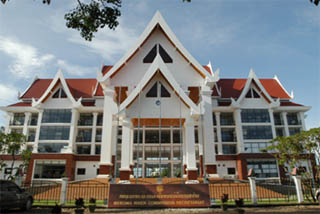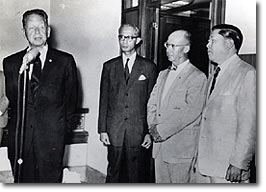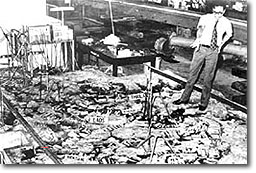About the MRC
Visions and Mission
VISION for the Mekong River Basin
An economically prosperous, socially just and environmentally sound Mekong River Basin
VISION for the Mekong River Commission
A world class, financially secure,International River Basin
Organisation serving
the Mekong countries to achieve the basin Vision
MISSION of the Mekong River Commission
To promote and coordinate sustainable management and development
of water and
related resources for the countries' mutual benefit and
the people's well-being
![]() The Mekong River Commission (MRC)
The Mekong River Commission (MRC)
![]() The National Mekong Committees
The National Mekong Committees
![]() Dialogue Partners China and Myanmar
Dialogue Partners China and Myanmar
![]() The Story of Mekong Cooperation
The Story of Mekong Cooperation
The Mekong River Commission (MRC) was established in 1995 by an agreement between the governments of Cambodia, Lao PDR, Thailand and Viet Nam.
The Agreement on the Cooperation for the Sustainable Development of the Mekong River Basin came about as the four countries saw a common interest in jointly managing their shared water resources and developing the economic potential of the river. Signed on 5 April 1995, it set a new mandate for the organisation "to cooperate in all fields of sustainable development, utilisation, management and conservation of the water and related resources of the Mekong River Basin".
The agreement brought a change of identity for the organisation previously known as the Mekong Committee, which had been established in 1957 as the Committee for Coordination of Investigations of the Lower Mekong Basin - the Mekong Committee.
Since the 1995 Agreement, the Mekong River Commission (MRC) has launched a process to ensure "reasonable and equitable use" of the Mekong River System, through a participatory process with National Mekong Committees in each country to develop procedures for water utilisation. The MRC is supporting a joint basinwide planning process with the four countries, called the Basin Development Plan, which is the basis of its Integrated Water Resources Development Programme. The MRC is also involved in fisheries management, promotion of safe navigation, irrigated agriculture, watershed management, environment monitoring, flood management and exploring hydropower options.
The two upper states of the Mekong River Basin, the People's Republic of China and the Union of Myanmar, are dialogue partners to the MRC.
The MRC is funded by contributions from the four member countries and from aid donors. Formal consultation with the donor community is carried out through an annual Donor Consultative Group meeting.
Structure
The MRC consists of three permanent bodies: The Council, the
Joint Committee (JC) and the Secretariat.

The Council, which meets once a year, consists of one member from each country at ministerial or cabinet level. The Council makes policy decisions and provides other necessary guidance concerning the promotion, support, co-operation and co-ordination of joint activities and programmes in order to implement the 1995 Agreement. The Council has overall governance of the Mekong River Commission.
Members of the MRC Council
CAMBODIA H.E. Mr Lim Kean Hor |
THAILAND H.E. Mr Suwit Khunkitti |
|
LAO PDR H.E. Ms Khempheng Pholsena |
VIET NAM H.E. Dr Pham Khoi Nguyen |
The Joint Committee (JC) consists of one member from each country at no less than Head of Department level. The Joint Committee is responsible for the implementation of the policies and decisions of the Council and supervises the activities of the Mekong River Commission Secretariat. This body functions as a board of management.
Members of the MRC Joint Committee
CAMBODIA H.E. Mr Sin Niny |
THAILAND Dr Saksit Tridech |
|
LAO PDR Mme. Monemany Nhoybouakong |
VIET NAM Dr. Le Duc Trung
|

The MRC Secretariat in Vientiane, Lao
PDR
The MRC Secretariat
is the operational arm of the MRC. It provides technical and
administrative services to the JC and the Council, is under
the direction of a Chief Executive Officer (CEO) who is appointed
by the Council. Under the supervision of the Joint Committee,
the Chief Executive Officer (CEO) is responsible for the day-to-day
operations of around 155 professional and general support staff.
The Secretariat is located in Vientiane, Lao PDR. The Assistant
CEO is of the same nationality as the JC Chair and serves a
one-year term. The main counterparts for MRC activities in the
four member countries are the National Mekong
Committees (NMCs).
The National Mekong Committees coordinate MRC programmes at the national level and provide links between the MRC Secretariat and the national ministries and line agencies. The principal implementing agencies of the MRC programmes and projects are the line agencies of the riparian countries in the Lower Mekong Basin. They are served by the respective National Mekong Committee Secretariats in each country.
Dialogue Partners China and Myanmar
In 1996 The MRC held its first Dialogue Meeting with its Dialogue
Partners China and Myanmar.
On 1 April 2002 The People's Republic of China signed an agreement
on the provision of hydrological information on the Lancang/Mekong
River. Under this agreement China now provides water level data
in the flood season from two stations located on the Upper Mekong
in China. This information is fed into the MRC's flood forecasting
system. Talks are under way to expand this data sharing agreement
to include dry season levels. China contributes 16% of the flow
of the Mekong River.

Opening of Mekong Committee office in Bangkok by
Dag Hammarskjold(left), Secretary-General of the
United Nations, 1959.
The Story of Mekong cooperation begins in the middle of the 20th century with the formal signing of the Geneva Accords, when the newly independent nations of Cambodia, Laos and Viet Nam took their places on the world stage.
Studies of the Mekong by the United Nations' Economic Commission for Asia and the Far East (ECAFE) and the US Bureau for Reclamation sparked interest in the Lower Mekong countries and at the newly established ECAFE, for a grand scheme to develop what was thought of as one of the world's great 'untamed rivers'.
No international river body had ever attempted to take on such encompassing responsibilities for financing, construction, management and maintenance of projects on an international river.

An early model used to study river flow in the
Vientiane-Nongkai area
The "Mekong Project' was the largest single development project the fledgling United Nations organisation had ever undertaken.
When the Mekong Committee began its work, there were no models to follow. In its early days, the Committee was guided and supported by ECAFE and the United Nations Development Agency.
Lack of stability in the region resulted in the interruption of Mekong Committee sessions in the late 1970s. In response to Cambodia's absence, in 1977 Lao PDR, Thailand and Viet Nam adopted a new statute forming the basis of the Interim Mekong Committee.
When Cambodia finally requested readmission in 1991, lengthy discussions began which led to the eventual transformation of the Mekong Committee through the 1995 Agreement on the Cooperation for the Sustainable Development of the Mekong River Basin.

Signing of the Interim Mekong Committee statute, 1978.
The '95 Agreement was a coming-of-age for the Mekong Committee, now the Mekong River Commission. No longer under the umbrella of ECAFE/ESCAP and the UNDP, its Articles give full management responsibility of the Commission to a Council of Ministers of member countries.
The Articles of the '95 Agreement have retained much of the original 'Mekong Spirit', but have shifted the focus from development of large-scale projects to sustainable development and management of natural resources.

From 1955 through to the mid-1960s, the Mekong Committee conducted hundreds of surveys and studies. Teams of experts traveled up and down the mainstream and its tributaries in boats, in jeeps, on foot, and on the backs of elephants to map, measure, sample and catalogue a rich diversity of resources. These studies were the basis of an ever-expanding 'knowledge base' now maintained by the Mekong River Commission.

Since the 1995 Agreement, the member countries have signed sub-agreements on Data and Information Sharing and Exchange, a Flood Management and Mitigation Strategy, and a formal agreement with China on the exchange of hydrological and other data.
The aim of many early Mekong Committee surveys was to gather data for irrigation flood control and hydropower projects. Over the last 50 years, much has been learned about dams and their impacts
The Commission has responded with a hydropower development strategy based on principles that recognise the rights and needs of multiple users, the value of public participation in planning, and protection of the environment. Similarly, the knowledge gained from early efforts to 'control' floods led to greater understanding of flood management and mitigation.
The Mekong Committee was born in an era of enormous optimism in science, technology and international development assistance. It was thought that whatever the problem, technology could and would provide the solution.
Few of the proposed projects were ever realised, but the early surveys and data collection were the beginning of the Committee's work as a natural resource planning advisor to its member governments.
A new paradigm has been steadily emerging.
People are coming to see nature and the environment as a complex web of interacting systems that we must learn to manage cooperatively, not exploit.
U Thant, Secretary-General of the United Nations in the 1960s, once described the vision of the Mekong Project as a "struggle to build a modern civilisation on the foundations of our ancient cultural heritage and to blend western technology with our own traditional values."
Since 1995, the Mekong River Commission has made slow but sure progress towards implementation of the agreement.
A common thread through all of its work is the facilitation of agreements between the four member countries on water use, water quantity and water quality.
The Basin Development Plan of 2002 is a basin-wide planning process rather than a specific list of projects. Planning today means 'participatory planning' and plans are informed by a much expanded range of stakeholders than was once the norm.
The organisation itself has undertaken a radical restructuring to lay the basis for a modern river basin management body.
In a 1966 editorial the Executive Secretary of ECAFE, U Nyun, observed that, "History is full of examples of countries, large and small, that have lost national independence because they have failed to grasp the need of international cooperation." The 1995 Agreement that transformed the Mekong Committee into the Mekong River Commission is an expression of just such international cooperation.
Developing water resources is one of the most complex and sensitive activities humans can attempt. Many different needs must be served and those needs are often competing or conflicting.
Water is seen by some as 'the' foreign policy issue of the 21st century. The nations of Southeast Asia who conceived and nurtured a Mekong Committee may prove to be a model for the world.
Choose a newsletter:

 Top
Top